Introduction
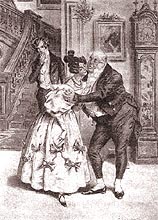
Fig. 1. Early scene illustrating the custom of kissing under the mistletoe (10). |
|
Not many generations ago, before the advent of television and home entertainment centers, neighbors and relatives frequently visited each other for fellowship and did so especially during the holidays. A common custom at Christmas-time was for the homemaker to place a sprig of mistletoe above a door frame or hang it from the ceiling of the dwelling. During the frequent get-togethers, any female who lingered there was fair game for a harmless kiss from nearby males (Fig. 1). During the Yule season, mistletoe plants were sold in the market place and were as plentiful there as holly and the other widely used Christmas greenery. Today, greenery is still much used, but the use of mistletoe is seldom practiced even though almost everyone has heard of the custom of kissing under the mistletoe. In an era of televised and widely accepted sexual freedom such a custom seems sweetly quaint and naive and perhaps is not sophisticated enough to survive our modern moral standards.
Mistletoes are flowering plants (angiosperms) that obtain their nutrition by living on and parasitizing other plants. This relationship was observed across the European continent by ancient peoples who were so impressed with these plants that the mistletoe became interwoven into legends, myths, and religious beliefs (Fig. 2). It will be my purpose to acquaint the reader with the historic origins of some of these customs, especially with those on the European continent, and why they have survived to some extent to the present day.
|
Fig. 2. Leaves, stems, and berries of mistletoe (Phoradendron sp.). Note ovate leaves, pale green color, jointed stems, and opposite branching. (Courtesy Illinois Natural History Survey) |
|
What Are Mistletoes?
Mistletoes are parasitic plants that directly derive all or most of their nutrition from other flowering plants during most or all of their life cycle. There are approximately 3,000 parasitic angiosperms in 15 plant families, and almost all are dicotyledonous. Although many parasitic plants contain functional chlorophyll, they depend on their plant hosts for most, or at least some, of their carbon requirements and for all of their other nutrient and water needs. By parasitizing other higher plants, they have a competitive advantage over many other forms of life because they do not have to compete in soil for their water and nutrient needs. The mistletoes originated in the tropics, where soils are typically poor in nutrition and competition within the soil between plants and microorganisms is fierce. At the end of the last Pleistocene glaciation event of 18,000 years ago, there was an active northward and southward migration and evolution of some of the mistletoes. A general description of mistletoes may be found in Tainter and Baker (9). A good over-view of the evolution of the mistletoes is given by Kuijt (8). Information on parasitic plants can be found on the website of The International Parasitic Plant Society, as well as at the delightful "The Parasitic Plant Connection" website by Dan Nickrent.
The group of parasitic plants collectively known as the mistletoes are contained in four families, but only two of these, the Viscaceae and Loranthaceae, are of widespread importance. The family Loranthaceae is large and contains at least nine genera, most of which are abundant in the tropics. Most species have large, showy flowers and attack a variety of tree hosts. The family Viscaceae contains several genera, but only Phoradendron and Viscum are important in the legends and myths relating to the mistletoes. On the European continent Viscum album was the major species with which primitive man interacted and which formed the basis for many myths, legends, and religious beliefs. This may have been because the mistletoe plant grew on oak trees, which were revered by many early European tribes, or because it retained its leaves in autumn when the oaks defoliated. When fresh, its leaves had a yellowish-green color, and its stems were a yellowish color. After it was cut and dried, the plant developed a golden yellow hue. In the southern half of the U. S., where the European mistletoe does not occur, Phoradendron spp. are the common leafy mistletoe (Fig. 3). They are very similar in appearance to the European mistletoe.
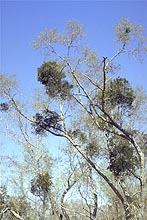
Fig. 3. Multiple infections of leafy mistletoe on an oak tree. (Courtesy F. H. Tainter). |
|
Species of Arceuthobium are known as dwarf mistletoes because of their lack of leaves and reduced visible growth habit (Fig. 4). They were of much less importance in the mistletoe legends, partially because they were relatively inconspicuous, and also because they were not present to any great extent on the European continent. They were abundant on the North American continent, but were of only minor importance in folklore as Europeans settled in northeastern North America. With the native American people, mistletoe seems to have been more important for its pharmaceutical properties than for its role in folklore (6).
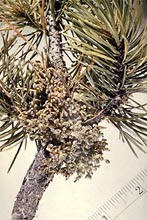
Fig. 4. Female dwarf mistletoe (Arceuthobium americanum) with mature fruits. (Courtesy D. W. French). |
|
History
As ancient European people interacted with their environment and began to reason why certain things were the way they were, they developed an intense interest in trees. Possibly because of the many amenities derived from trees, and especially the oaks, trees came to be worshiped by these early Europeans. This eventually led to another Christmas ritual that has survived almost to the present, along with the seasonal ritual use of mistletoe. As part of a series of rituals, they burned logs around the time of the winter solstice (5). After conversion of the people to Christianity, the tradition of burning logs was changed to begin early on Christmas eve. A log was to be kept burning all night, and this culminated in a great celebration on Christmas morning. This yuletide custom of burning the Yule log was widely practiced until only a few decades ago, and probably ceased with the advent of centralized heating. The decline in the use of mistletoe probably was due to other factors.
Although the Greek philosopher Theophrastus (370 to 270 BC) described the common European leafy mistletoe, it was Pliny the Elder (23 to 79 BC) who wrote detailed descriptions of the attitude of some people toward the mistletoe. He recorded the widely held belief that whatever grew on the sacred oak was sent from heaven and, since mistletoe was only occasionally found on the oak, it was indeed cause for celebration when it was encountered (4). Pliny also recorded the belief that the mistletoe in winter contained the life of the oak after it had lost its leaves the preceding autumn. It was believed that the mistletoe plant was protected in some mystical sense from injury or harm. If it was cut from the oak, it retained some of these mystical powers, which could be channeled as healing powers. However, if it touched the ground after it was harvested, its healing powers would be lost.
While mistletoe played an important part in some later Greek and Nordic myths and legends, its relationship with the ancient Celts, who lived in ancient Gaul, Britain, and Ireland, is one of the earliest known examples of the importance of mistletoe. The Druids, who were the priests of a Celtic religious order, regarded the leafy mistletoes as having mystical properties and worshiped them (10). This belief in mystical properties was due, at least in part, to the fact that mistletoes often grew on the branches of the revered oak tree. In the autumn, as the length of the day decreased, religious significance was focused on the winter solstice, the shortest day of the entire year. The people observed that the mistletoe plants growing on the oaks retained their leaves while at the same time the oaks lost theirs. During the winter, the golden boughs of the mistletoe plant, with its yellow-green leaves and large white berries, seemed to be a remarkable phenomenon, and thus, the mistletoe plant was believed to have mystical properties.
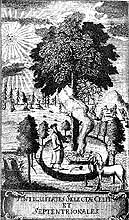
Fig. 5. Scene of Druids worshiping the leafy mistletoe (10).
|
|
The Druids also had a ceremony at Midsummer Eve which involved cutting a mistletoe plant from an oak tree with a golden sickle to initiate a ceremony in which animals and human beings were slain and burned (Fig. 5). When the Celts were later Christianized, they may have found it difficult to completely abandon their respect for the mistletoe plant, and it somehow became incorporated into a supposedly harmless custom which the early Christian church overlooked, even though it was widely practiced by its members.
While a feeling of veneration for mistletoe was widely shared by early European peoples, it was the Greeks who incorporated mistletoe into some of their myths and legends. The "Golden Bough" of Virgil's hero, Aeneas, was in fact mistletoe (5). Aeneas was arbitrarily chosen by the Latin poets to be the mythical progenitor of the Roman people. It was Aeneas' wish to visit hell, but on his way there he first had to pass through a vast and gloomy forest. Two doves guided him to a tree bearing a mistletoe plant (Fig. 6). He took the golden bough, and with its flickering light he was able to pass through the forest. When he emerged from the forest and showed the bough to the reluctant ferryman at the river Styx, both were immediately transported to the nether world. Such was the power of the mistletoe plant!
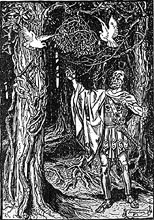
Fig. 6. Aeneas, discovering the Golden Bough (3). |
Another popular myth that involved mistletoe was that of the Norse god Balder (1). The myth held that the heavenly bodies, which included the gods, were created fresh every day. Odin, Balder's father, tried to help prolong Balder's life beyond that day and extracted a promise from all living beings not to harm him. However, he overlooked the mistletoe, and during archery practice, a rival gave an arrow made from a twig of mistletoe to Balder=s blind brother who accidentally shot Balder and killed him. This doesn't make too much sense to us today, but it probably made good logic at that time within the constraints of a myth. Probably as a result of trial and error, mistletoe plants were also found to have certain medicinal properties, and knowledge of these characteristics undoubtedly contributed to the mystical nature of mistletoe. In the ancient language of the Druids, mistletoe meant "all-healing." Some attributes were undoubtedly based in truth. However, others were certainly based on faulty reasoning. For example as late as 1900, an interesting use of mistletoe was for the treatment of epilepsy (10), which two millennia earlier was documented by Pliny. The rationale was that since mistletoe was rooted in the branch of a tree, and could not possibly fall to the ground, so too, an epileptic who took a decoction of mistletoe or carried it in his pocket could not possibly fall to the ground. A good review of pharmaceutical and other uses of mistletoes is given in Gill and Hawksworth (6).
From the Middle Ages to the last century, the literature is filled with examples of different uses for mistletoe plants, especially among rural people (4,5,10). It was cut, tied in bunches, and hung in front of cottages to scare away passing demons. It was hung over doors of stables to protect horses and cattle against witchcraft. In Sweden, it was kept in houses to prevent fire. It Italy it was believed to be able to extinguish fire. It was widely held to be a universal healer. As a potion it would make barren animals conceive. Even Pliny had known it was a cure for epilepsy, and that it could be used to promote conception. It healed ulcers if chewed. In Wales it was thought that, if placed under a pillow, mistletoe would induce dreams of omen. There were various customs in several countries that utilized mistletoe plants in rituals to find treasure. Collectively, these customs prove that mistletoe had a profound effect on people's lives and imaginations.
When Christianity became widespread in Europe after the 3rd century AD, the religious or mystical respect for the mistletoe plant was integrated to an extent into the new religion. In some way that is not presently understood, this may have led to the widespread custom of kissing under the mistletoe plant during the Christmas season, possibly relating to the belief in the effects on fertility and conception. The earliest documented case of kissing under the mistletoe dates from 16th century England, a custom that was apparently very popular at that time (10).
Much less is known about early historical aspects of the dwarf mistletoes. Because the plants of the dwarf mistletoes were small in size and not very abundant on the European continent, there is no record that ancient peoples of this region took any interest in the dwarf mistletoes. Although there are several species of dwarf mistletoes (Arceuthobium) in the European, Asian, and African continents, their most extensive development occurred in Central and North America, where there are over 3 dozen species of dwarf mistletoes (7). One of the smallest and most evolutionarily advanced species is Arceuthobium pusillum, which is found mainly in the spruce forests of eastern Canada and the eastern United States. The leafy mistletoes do not occur there because it is too cold in winter. However, even though the leafy mistletoes were not found there, Fernald (2) states that the women of the St. John and St. Lawrence River valleys wore sprigs of dwarf mistletoe in their hair while attending dances, following the European custom of women wearing leafy mistletoe in their hair, long before this species of dwarf mistletoe was known to science.
|
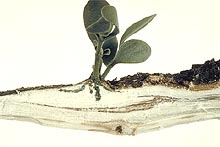
Fig. 7. Infection of leafy mistletoe, showing dark green sinkers in the twig. (Courtesy of Carolina Biological Supply Co., Elon College, NC).
|
Biology of Mistletoe
Most parasitic higher plants use a similar process of infection. Upon germination, a root-like structure, called a radicle, emerges from the germinated seed and grows along the branch surface by a process known as thigmotropism. When it encounters an irregularity in the bark, the radicle will produce a swelling called a holdfast. A cementing substance may be secreted to bind the holdfast to the bark. A wedge-shaped structure, called a penetration peg, then forms to penetrate into the cortex of the host. Once established in the host's cortex, an intimate connection forms between phloem and xylem cells of the mistletoe and the phloem and xylem cells of the host, and the mistletoe plant then absorbs nutrients and water. These connections form structures called sinkers (Fig. 7).
One year or more after the mistletoe plant has infected the host, it will begin to produce the foliar parts of the plant. The mistletoe plant grows larger, producing a branched, golden-colored woody stem and yellow-green to dark green leathery leaves. The chlorophyll of leafy mistletoes is functional and photosynthesis is sufficient to supply all of their carbon needs. In mid-autumn small, round, pearl-like berries form (Fig. 8), and these enlarge to maturity in early winter. After they are mature, birds eat the berries and the seeds are carried away to begin new infections or the berries simply break off the plant and fall to lower branches to initiate new infections on the same tree or on understory vegetation.
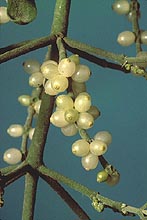
Fig. 8. Female leafy mistletoe plant, Phoradendron sp., showing large, white fruits. |
|
Leafy mistletoe plants are perennial and remain alive within their respective host until the tree host, or the branch upon which it is established, dies. Since the leafy mistletoes can photosynthesize enough carbon to meet their needs, they only need to extract water, and whatever mineral nutrients the water contains, from their hosts. Thus, while they are obligate parasites in that they can only live and reproduce on a living host, they do not necessarily cause a debilitating nutritional drain on the host. A single infection on one branch, or only a few infections on an otherwise vigorously growing tree, seems to cause no noticeable harm to the tree. Often, though, that portion of a branch beyond the point of a single infection may become stunted in growth and even die prematurely. Multiple infections, sometimes dozens or even hundreds on a single tree, may produce a significant stress to the host tree that can either kill it outright or create stressful conditions attractive to secondary disease pests and insects that then cause premature death.
Seed dissemination of the leafy mistletoes is largely passive. The leafy mistletoes have a single-seeded berry which, when mature, contains viscin, a watery-sticky substance. Some local dissemination results when mature seeds are washed downward onto lower branches. Most distant dissemination occurs when birds feed on mistletoe berries or seeds. The seeds then either pass uninjured through the bird's digestive system or they adhere to the bird's plumage and feet and are removed during preening. Thus, dispersal of the seeds occurs wherever the bird defecates or preens its foliage.
The vsicin coating of each seed consists of numerous slender, spring-like cells that are embedded in a mucilaginous substance. Following dispersal, these viscin cells wrap around irregularities on the bark and help to glue the seed in place until it germinates and initiates a new infection. In Europe viscin was long used for the manufacture of birdlime, a sticky substance used to trap birds (10).
Infection by leafy mistletoes produces a slight, spindle-shaped swelling on the host at the infection site. If one makes a cross section through the swelling, the mistletoe tissues (mostly sinkers) will be a bright yellow-green or green in color and are easily distinguished from host tissues. The dark yellow-green to green woody stems are rather coarse in appearance and with relatively smooth but somewhat wrinkled bark.
The leafy mistletoes are generally not considered a serious enough threat to warrant the need for control measures. Exceptions might include fruit orchards, intensively managed plantations, or historically valuable or visually important specimen trees. In North America, the range of leafy mistletoes does not extend north of a line drawn across the United States from approximately Oregon to New Jersey, as they are susceptible to freezing temperatures. There are about a dozen species of Phoradendron in the U.S. They occur mostly on hardwood tree species, but some also occur on juniper, cypress, and incense cedar. Phoradendron flavescens attacks pecans in Florida, citrus in Texas, and walnuts and persimmons in California. Phoradendron juniperinum libocedri and P. bolleanum pauciflorum cause significant losses on incense cedar and white fir in California.
Today, leafy mistletoes are commonly encountered on many urban and forest hardwood tree species. In a well-documented case, the famous horticulturist, Luther Burbank, imported the common European mistletoe into California in the early 1900s, and it has subsequently spread into the surrounding landscape on 24 species including willow, alder, poplar, elm, mountain ash, crabapple, and pear. In its native Europe, this mistletoe also attacks apple, almond, cherry, pine, fir, and poplar in parks, orchards, forests, and plantations.
Physical removal by cutting out infections of leafy mistletoes is certainly warranted in some situations. Care must be taken to remove all of the infection in the branch, as any living mistletoe tissues that remain are capable of regenerating into whole plants. The cut branches do not have to be burned or destroyed because the mistletoe plants die quickly. Some experimentation with herbicides suggests that these might be of value in less intensively managed forest situations, but are probably not economically justified.
A quarantine of infected plant materials would not seem to be difficult, as the mistletoes require living hosts in order to survive for extended periods of time in forms other than as seeds. The eradication of mistletoes around nurseries should ensure mistletoe-free seedlings. On the other hand, during the last century growth of mistletoe was encouraged in the western United States so that the foliage could be used as a supplemental cattle feed during especially harsh winters and coincidentally to harvest and sell during the Christmas season. In some gardens and arboreta mistletoe is propagated as a valued horticultural oddity.
Today, most of the mystical aspects of the mistletoes are not celebrated. Certainly we have a more realistic understanding of their pharmaceutical and medicinal properties. However, I think that most of the interest in them is based on their unique parasitic nature, perhaps similar to that observed in ancient times. But, our modern interest is based on the physiology of this parasitic nature in many different host-parasite interactions and the complex series of events during their evolution which resulted in their formation and development. Let us hope, though, that the old custom of kissing under the mistletoe at Christmas time is not lost.
Additional Resources
Mistletoe is for Life
The Parasitic Plant Connection
The International Parasitic Plant Society
The Mistletoe Center
Dwarf Mistletoes: Biology, Pathology, and Systematics
Literature Cited
1. Cox, G. W. 1883. An Introduction to the Science of Comparative Mythology and Folklore. Kegan Paul, Trench, and Company, London. [Reprint, Singing Tree Press, Detroit, 1968.
2. Fernald, M. L. 1900. Arceuthobium pusillum in the St. John and St. Lawrence valleys. Rhodora 2:10-11.
3. Frazer, J. G. 1890. The Golden Bough: A Study in Comparative Religion. Macmillan, London. [Reprint, Crown Publications, Inc., Victoria, BC, Canada, 1981.
4. Frazer, J. G. 1922. The Golden Bough: A Study in Magic and Religion, a New Abridgement from the Second and Third Editions. Macmillan, New York, NY. [Reprint, Oxford University Press, London, 1994.]
5. Frazer, L. 1924. Leaves From the Golden Bough. Macmillan, New York.
6. Gill, L. S., and Hawksworth, F. G. 1961. The Mistletoes: A Literature Review. USDA Forest Service, Technical Bulletin Number 1242.
7. Hawksworth, F. G., and Wiens, D. 1996. Dwarf Mistletoes: Biology, Pathology, and Systematics. USDA Forest Service, Agriculture Handbook 709.
8. Kuijt, J. 1969. The Biology of Parasitic Flowering Plants. University of California Press, Berkeley.
9. Tainter, F. H., and Baker, F. A. 1996. Principles of Forest Pathology. John Wiley & Sons, Inc., New York.
10. Von Tubeuf, C. 1923. Monographie der Mistel. Olderbourg, Berlin.
